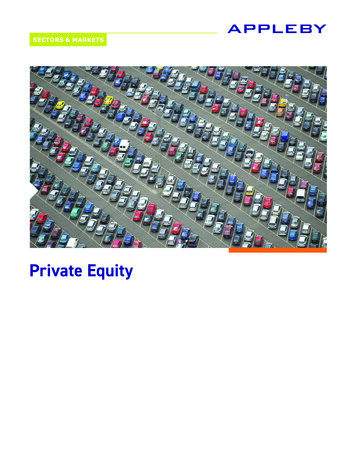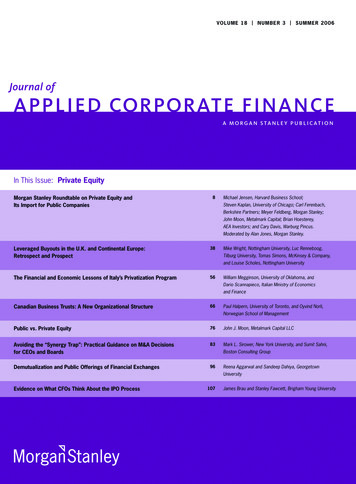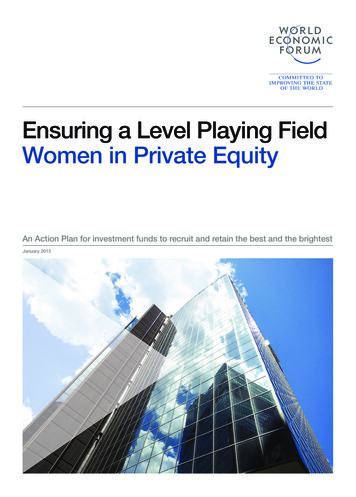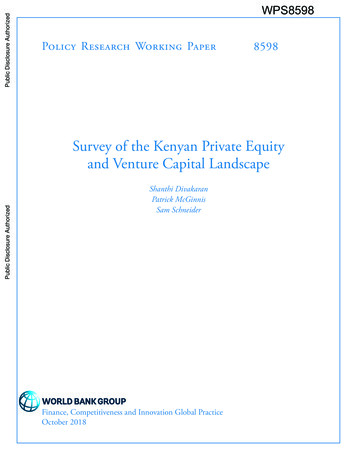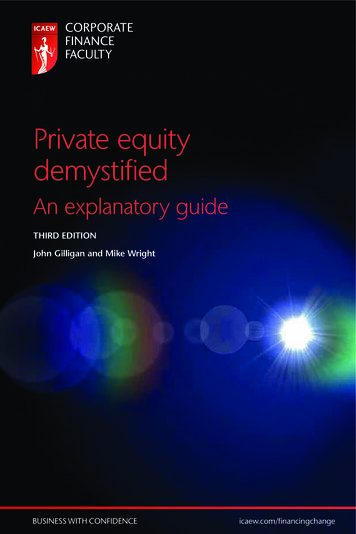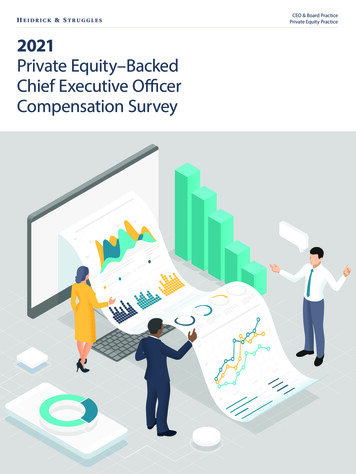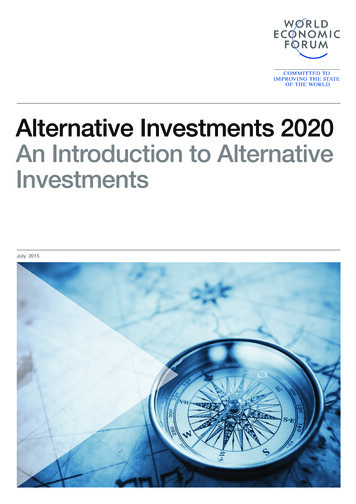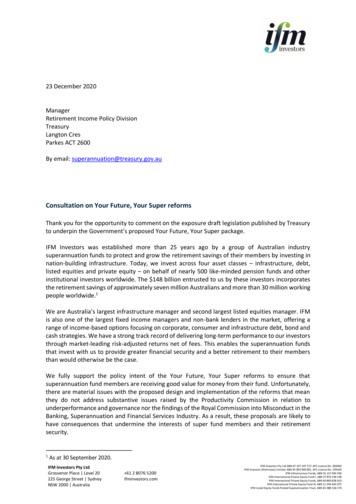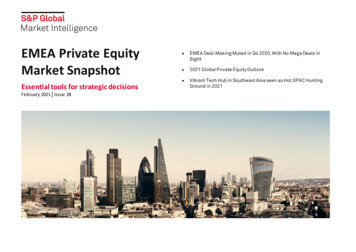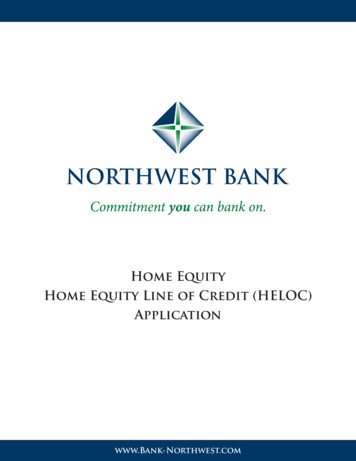
Transcription
GLOBAL PRIVATE EQUITY REPORT 2019
About Bain & Company’s Private Equity businessBain & Company is the leading consulting partner to the private equity (PE) industry and its stakeholders. PE consulting at Bain has grown eightfold over the past 15 years and now represents aboutone quarter of the firm’s global business. We maintain a global network of more than 1,000 experiencedprofessionals serving PE clients. Our practice is more than triple the size of the next largest consultingcompany serving PE firms.Bain’s work with PE firms spans fund types, including buyout, infrastructure, real estate and debt. Wealso work with hedge funds, as well as many of the most prominent institutional investors, includingsovereign wealth funds, pension funds, endowments and family investment offices. We support ourclients across a broad range of objectives:Deal generation. We help develop differentiated investment theses and enhance deal flow by profilingindustries, screening companies and devising a plan to approach targets.Due diligence. We help support better deal decisions by performing integrated due diligence to assessthe market dynamics, a target’s competitive position and margin expansion opportunities, and byproviding a post-acquisition agenda.Immediate post-acquisition. We support the pursuit of rapid returns by developing a strategic valuecreation plan for the acquired company, leading workshops that align management with strategic priorities, and directing focused initiatives or wholesale transformations.Ongoing value addition. We help increase company value by supporting revenue enhancement andcost reduction and by refreshing strategy.Exit. We help ensure that funds maximize returns by identifying the optimal exit strategy, preparing theselling documents and prequalifying buyers.Firm strategy and operations. We help PE firms develop distinctive ways to achieve continued excellence by devising differentiated strategies, maximizing investment capabilities, developing sectorspecialization and intelligence, enhancing fund-raising, improving organizational design and decision making, and enlisting top talent.Institutional investor strategy. We help institutional investors develop best-in-class investment programsacross asset classes, including private equity, infrastructure and real estate. Topics we address coverasset class allocation, portfolio construction and manager selection, governance and risk management,and organizational design and decision making. We also help institutional investors expand their participation in private equity, including through coinvestment and direct investing opportunities.Bain & Company, Inc.131 Dartmouth StreetBoston, Massachusetts 02116 USATel: 1 617 572 2000
Global Private Equity Report 2019ContentsThe beginning of the rest of the story?. . . . . . . . . . . . . . . . . . . . . . . . . . . . pg. 11.The private equity market in 2018: What happened?. . . . . . . . . . . . . . . . . . pg. 3Investments: More strength, same challenges . . . . . . . . . . . . . . . . . . . . . . . pg. 3Spotlight on China: Navigating the new economy . . . . . . . . . . . . . . . . . . pg. 13Exits: Strategic buyers keep the party going. . . . . . . . . . . . . . . . . . . . . . . pg. 17Fund-raising: The capital continues to flow. . . . . . . . . . . . . . . . . . . . . . . . pg. 21Spotlight on GP equity stakes: Will the bonanza continue?. . . . . . . . . . . . . pg. 27Returns: Despite a drop, PE still outperforms. . . . . . . . . . . . . . . . . . . . . . . pg. 32Key takeaways. . . . . . . . . . . . . . . . . . . . . . . . . . . . . . . . . . . . . . . . . . . pg. 362.What’s happening now: The strategies shaping private equityin 2019 and beyond . . . . . . . . . . . . . . . . . . . . . . . . . . . . . . . . . . . . . . . pg. 37Buy-and-build: Powerful strategy, hard to pull off. . . . . . . . . . . . . . . . . . . . pg. 37Merger integration: Stepping up to the challenge . . . . . . . . . . . . . . . . . . . pg. 46Adjacency strategy: Taking another shot at diversification . . . . . . . . . . . . . pg. 58Advanced analytics: Delivering quicker and better insights. . . . . . . . . . . . . pg. 673.Private multiples are ascendant: Is this the new normal?. . . . . . . . . . . . . . . pg. 73i
Global Private Equity Report 2019ii
Global Private Equity Report 2019The beginning of the rest of the story?Dear Colleague:The past five years have been ones of unprecedented success for the private equity industry. During thatspan, more money has been raised, invested and distributed back to investors than in any other periodin the industry’s history. Private investment in general, and private equity in particular, seems to be on asecular penetration curve that has no end in sight. Yet, there are also some cautionary notes to sound.Returns, while still strong relative to other asset classes, have slowly declined toward public market averages during the period. Persistent high prices, volatile capital markets, US–China trade arguments, Brexitworries and, of course, the ever-present threat of recession have injected a sense of uncertainty that dealmakers dislike. The pace of technological change is also increasing in almost every industry, making itharder to forecast winners and losers. So, while the good times are rolling, some bells of worry are tolling.In this, Bain’s 10th-anniversary Global Private Equity Report, we look fearlessly at the industry’sstrengths, its challenges and the evolutionary path that lies ahead. In addition to the critical statisticsthat characterize PE industry performance, you’ll find our assessment of how to do “buy-and-builds”properly and why this tactic is increasing in popularity. Building on last year’s assertion that PE firmsneed to increase their 10% share of the approximately 40,000 M&A deals done globally each year, wediscuss how firms are building merger integration muscles to better compete with corporate buyers,and why the integration process should begin during due diligence. We also take a hard look at adjacency strategy 2.0 and the new wave of equity products that many PE firms are moving into aggressively, hoping to find higher returns and more productive ways to invest capital at scale.In addition, we zero in on exciting topics such as advanced analytics, which speeds insight in bothdiligence and post-close value addition; liquidity solutions for general partners; and the Chinese PEmarket, which is on the leading edge in areas like technology.We close our 2019 review of important trends in private equity by getting out our crystal ball. It’s a bitcloudy (as is everyone’s), but we see fundamental shifts happening in capital markets that are likelyto drive a long-term trend toward much larger private capital (and private equity) opportunities vs.traditional public equity models. This ongoing movement will have seismic impacts for providers ofcapital, investors of that capital and for the companies owned by a widening variety of private models.It portends a future in which a much larger share of capital flows into private markets. Perhaps thisis indeed the beginning of “the rest of the story” for the PE industry.Hugh MacArthurHead of Global Private Equity1
Global Private Equity Report 20192
Global Private Equity Report 20191. The private equity market in 2018: What happened?As the current economic expansion chugged into its ninth full year in 2018, the global private equity(PE) industry continued to make deals, find exits and raise capital at a historic five-year pace. Limitedpartners (LPs) remain highly enthusiastic and have continued to flood the market with fresh capital.Keeping the momentum going, however, has hardly been easy.Chronically heavy competition has driven deal multiples to historic highs, and growing jitters aboutan eventual economic downturn are affecting decision making, from diligence to exit planning. Forgeneral partners (GPs), putting record amounts of capital to work means getting comfortable with acertain level of discomfort when investing. They are paying prices they swore they would never payand looking to capture value that may prove elusive post-close. The most effective GPs are steppingup their game to identify targets and sharpen diligence, while simultaneously planning for the worst.In Sections 2 and 3, we’ll explore several strategies firms are using to make the most of an increasinglydifficult market. In the meantime, here’s what happened in 2018. Investments: More strength, same challengesAmid heavy pressure to do deals, the PE industry saw another impressive surge in investment valuein 2018. Fierce competition and rising asset prices continued to constrain deal count—pushing downthe number of individual transactions by 13%, to 2,936 worldwide—but total buyout value jumped 10%to 582 billion (including add-on deals), capping the strongest five-year run in the industry’s history(see Figure 1.1).While the current investment cycle hasn’t been a steady upward march, especially in terms of dealcount, it has shown great resilience and overall strength. Every year since 2014 has produced higherdeal value than any year in the previous cycle, with the exception of the peak in 2006 and 2007. Overthis period, the industry has benefited from an unprecedented wave of investor interest, buttressedby ebullient equity markets, low interest rates and steady GDP growth in the US and Europe. For GPs,it has been a remarkable run.Predictably, experts are debating how long the good times can last. Only one other US recovery onrecord (from 1991 to 2001) has extended as long as this one. While GDP growth in the West remainsstrong, US interest rates are rising as inflation picks up in the US and Europe. Slowing growth inChina, global trade tensions, ongoing uncertainty about Brexit and year-end market volatility are allfueling concern that this cycle may be running its course.For PE firms, however, the question isn’t so much when the next downturn will appear as how to negotiate it successfully when it does. With record amounts of capital to invest, it doesn’t pay to sit idle tryingto time the downturn. Instead, GPs are finding ways to cope with a growing level of macro uncertainty3
Global Private Equity Report 2019Figure 1.1: Rising deal value in 2018 capped the strongest five-year stretch in history, while dealcount reflected stiff competition and rising asset pricesGlobal buyout deal value (including add-on deals)Deal count 1,000B5,0008004,0006003,000Total countRest of 8)North America–13%–53%–4%9%22%001996 97 98 99 00 01 02 03 04 05 06 07 08 09 10 11 12 13 14 15 16 17 18Add-on count 9 17 25 25 27 33 29 27 28 29 29 33 36 36 37 41 40 40 45 48 48 49 42percentageAdd-on value 14 16 16 15 20 16 8 11 12 17 10 11 13 21 12 25 21 14 31 43 21 24 23percentageNotes: Excludes loan-to-own transactions and acquisitions of bankrupt assets; based on announcement date; includes announced deals that are completed orpending, with data subject to change; geography based on target’s locationSource: Dealogicand planning carefully for how they can profit from the downturn. With the global financial crisisfresh in their memories, firms are focusing their diligence much more intently on downside scenariosthis time around. They learned valuable lessons during the crisis about what holds up well throughthe cycle—or not—and are adjusting accordingly. Even within a sector like healthcare, widely viewedas recession-resistant, there were subsector differences in performance worth noting. Healthcaresupport services, for instance, produced multiples of better than two times invested capital, whilehealthcare equipment and pharmaceuticals fared less well, according to CEPRES, a digital investmentplatform and transactional network for the private capital markets (see Figure 1.2).Spotting pockets of opportunity has been a challenge even in the up-cycle. For GPs, finding the rightasset at the right price was the biggest constraint on doing deals in 2018. That helps explain why thenumber of transactions has remained stubbornly flat, bouncing around between 3,000 and 4,000buyouts per year since 2010. Indeed, despite the industry’s impressive showing over the last five years,it has failed to carve out a larger share of the global market for mergers and acquisitions, which hashovered around 40,000 transactions per year for a decade (see Figure 1.3).When asked what most gets in the way of closing more deals, GPs cite the same challenges they havefaced for years: high deal multiples, a dearth of attractive targets and stiff competition (see Figure 1.4).GPs are clearly hungry to do more deals, but when they find attractive assets, they consistently encounter aggressive corporate buyers willing to push up auction prices. These buyers are strategic,4
Global Private Equity Report 2019Figure 1.2: Returns during the global financial crisis were all over the map—between sectors andwithin sectorsGlobal buyout equity capital invested, by sector and subsector ation servicesNatural resources/energy equipmentand services80Specialized consumer services60General industrialsInternetFood and Other SoftwareMediaBusiness support servicesIndustrialsGross pooled MOICHealthcarefacilitiesTravel and leisureChemicals0Misc.Pharma andbiotechConsumerLess than lthcare ServicessupportservicesHealth- FinancialcareservicesGreater than 2.5xMiscellaneousTelecominfrastructureNatural resources/energyinfrastructureTelecomequipmentand servicesOtherUnavailableNotes: Includes realized and unrealized buyout deals with invested equity capital of 50 million or more and initial investment between January 1, 2006, andDecember 31, 2008; MOIC stands for multiple of invested capitalSource: CEPRES PE.AnalyzerFigure 1.3: Private equity is not increasing its share of the total market for mergers and acquisitionsDeal valueDeal countGlobal buyout share of total M&AGlobal buyout share of total M&A30%15%201010500200405 06 07 08 09 10 11 12 13 14 15 16 17 18200405 06 07 08 09 10 11 12 13 14 15 16 17 18Notes: Total M&A is the sum of corporate M&A and buyouts, including add-ons; corporate M&A excludes transactions in which the acquirer is a government entity;based on announcement date; includes announced deals that are completed or pending, with data subject to changeSource: Dealogic5
Global Private Equity Report 2019Figure 1.4: High multiples, a dearth of targets and stiff competition continue to be the biggestchallenges for PE firms looking to close dealsWhat do you anticipate to be the biggest challenges for PE dealmakers in 2018?More importantHigh transaction multiples2.3Deal sourcing/lack of quality assets2.9Competition3.1Political uncertainty4.0Regulatory environmentLess important4.1Access to financing4.8012345Mean of responses by category(1 as most important and 7 as least)Source: Crystal Ball Report 2018, PitchBook Data, Inc.meaning they will pay more to advance corporate objectives and capture synergies. Increasingly, theyare showing up at all ends of the market as they search for ways to spur new growth through acquisition.Large deals, especially a spate of very large carve-out transactions, helped boost deal value in NorthAmerica by 22% in 2018. The year’s largest buyout was the 17 billion carve-out of Thomson Reuters’Financial & Risk unit, led by Blackstone and the Canada Pension Plan Investment Board. Large publicto-private (P2P) deals, such as KKR’s 9.6 billion leveraged buyout (LBO) of Envision Healthcare, alsocontributed to the bump in value. The strong P2P activity in the US pushed the value of these dealsglobally to its highest level since the previous take-private boom in 2006–07 (see Figure 1.5). The reason:Despite the run-up in equity prices, public investors often undervalue companies they don’t understand.“If you have a complicated story, you’re not really welcomed so much in the public market,” said JoshHarris, the cofounder of Apollo Global Management, which took LifePoint Health private in 2018. “Thatis creating a very fertile hunting ground for private equity, and we do see more opportunities here.”Sponsor-to-sponsor deals also provided a rich vein of opportunity in 2018. That was especially true inEurope, where deals between PE funds dominated in terms of both value and deal count, as they havesince 2010. Partners Group led a consortium including CDPQ and the Ontario Teachers’ Pension Planin the 5.4 billion acquisition of Techem, a global leader in heat and water submetering services, fromMacquarie. EQT acquired Azelis from Apax Partners for 2.3 billion. It was the fourth consecutivesponsor-to-sponsor transaction for Azelis, a global distributor of specialty chemicals and food ingredients.6
Global Private Equity Report 2019Figure 1.5: Public-to-private deals reached their highest level since the previous boom years, interms of both value and countGlobal public-to-private deal valueDeal count200 0810874482709101112969715165045131417180Previous boom yearsTotal countNorth AmericaEuropeAsia-PacificRest of worldNotes: Includes add-ons; based on announcement date; includes announced deals that are completed or pending, with data subject to change; geography basedon target’s locationSource: Bain global public-to-private deal databaseSponsor-to-sponsor deals get a bad rap because they can be inefficient in terms of repeated transactionfees, and the paths to value creation may be less obvious. Yet PE firms continue to see value in them.Indeed, Apax Partners netted a 3.5 times return when it sold Azelis. Working with another firm onthe sell side can make deals significantly easier by speeding up both diligence and the transactionprocess. Previous PE ownership also generates a reliable track record and reassures buyers that anytime bombs have likely been found and defused. Research consistently shows that sponsor-to-sponsordeals have performed at least as well as primary buyouts over time, often with less risk. When dealshave gone bust, failure was frequently the result of factors that could affect any business, whether ornot it was previously owned by a PE firm.What’s clear is that GPs are hard at work searching out value wherever they can find it. After years ofrecord-level fund-raising, PE funds are awash in capital and face a growing need to put large amountsof money to work. Despite the strong pace of investment since 2014, PE dry powder, or uncalled capital, has been on the rise since 2012 and hit a record high of 2 trillion in December 2018 across allfund types (see Figure 1.6). That stockpile raises concerns that the industry may be getting ahead ofitself, much as it did in 2007 and 2008, when the global financial crisis slammed the brakes on dealmaking, leaving GPs holding years’ worth of uncalled capital and seeking extensions.While the level of dry powder bears watching, a closer analysis of the dynamics at work today suggests there’s little danger of the buyout industry falling too far out of balance. Based on current deal7
Global Private Equity Report 2019Figure 1.6: Dry powder continues to pile up globally, setting a new record in 2018Global PE dry powder2.0 .0CAGR(17–18)–1%Other10%MezzanineDirect lending31%Distressed PE7%Infrastructure8%Growth28%Venture capital11%Real estate5%0.60.40.42003 04Buyout0506070809101112131415161715%18As of year-endBuyout ( B) 184 176 256 374 438 478 479 424 392 357 424 441 475 516 602 695Note: Discrepancies in bar heights displaying the same value are due to roundingSource: Preqinvalues, the dry powder held in buyout funds today represents 3.0 years of investment, vs. 4.6 years in2007 and 2008. That duration is well below the buyout industry’s typical five-year investment timeframe, suggesting that GPs have time to get unspent capital into the market. Of course, durationwould rise if a recession developed over the next couple of years, but it would take a major downturnto produce a significant spike. Dealmaking would have to drop to the 2010–12 average for a sustainedperiod of time—an unlikely scenario—for duration to push back above the five-year mark. It helpsthat PE funds are accumulating mostly “young” capital, raised by funds with recent vintages. Buyoutfirms hold 67% of their dry powder in funds raised in the last two years (see Figure 1.7). That meansthe recent deal cycle is clearing out the older capital and replacing it with new.The debt markets encouraged GPs to keep doing deals through much of 2018. Despite the rise in USinterest rates, the updraft was slow to be felt in loan pricing. Lenders, meanwhile, were competing aggressively to extend credit on easy terms. So-called covenant-lite loans have become increasingly commonin lending markets in the second half of this cycle, and debt multiples have entered territory not seensince the peak of the last cycle. In the years following the global financial crisis, regulators discouragedmultiples of six times earnings before interest, taxes, depreciation and amortization (EBITDA). Yet inthe Trump era’s more relaxed regulatory environment, the share of deals with multiples of greater thanseven times EBITDA rose to almost 40% of the total, according to Loan Pricing Corp. (LPC), whichtracks the syndicated loan market (see Figure 1.8). The true leverage deployed in many deals may alsohave been understated: As is often the case in times of high risk tolerance, banks have allowed borrowers8
Global Private Equity Report 2019Figure 1.7: Firms are holding the majority of their dry powder in their youngest-vintage fundsDistribution of global buyout dry powder, by fund age100%Older2–5 years806040Younger than2 years2002009101112131415161718As of year-endSource: PreqinFigure 1.8: Highly leveraged buyouts have become increasingly commonShare of overall US LBO market, by leverage level80%6x leverageor greater60407x leverageor greater20020030405060708091011Source: LPC912131415161718
Global Private Equity Report 2019to calculate multiples based on projected earnings instead of actual results. Such calculations tend tobake in expectations for cost cutting, synergies and revenue increases that may or may not materialize.As hot as the debt markets were for most of 2018, there were signs near year-end that things werecooling off. Amid heavy market volatility, Bloomberg reported that US leveraged loan funds saw 15.7 billion in outflows from November 21 to January 2, a seven-week rout that included the worstweek on record. The news service also reported that Wells Fargo and Barclays had failed to sell a 415 million leveraged loan related to Blackstone’s 700 million purchase of oil services firm UlterraDrilling Technologies. Bloomberg said the banks reportedly planned to hold the loan on their booksuntil they could once again try to unload it in January.The heavy competition for assets and the flood of capital—both debt and equity—into the marketsince 2014 has had the inevitable effect of raising asset prices to all-time highs. The average multiplefor leveraged buyouts in the US and Europe has hovered around 11 times EBITDA in recent years,above levels leading up to the global financial crisis (see Figure 1.9).These dynamics—abundant capital on easy terms, pressure to do deals, rising asset prices and anuncertain economic outlook—raise all the usual end-of-cycle red flags. The best-positioned firms areadjusting their approach in several ways, both to win more auctions without overpaying and to hedgeagainst the risk of a downturn.Figure 1.9: The average multiple for US leveraged buyouts continues to hover near record-high levelsAverage EBITDA purchase price multiple for US LBO 0.310.711.010.99.3Equity/EBITDA7.76Junior 9101112Source: LPC10131415161718
Global Private Equity Report 2019 With asset prices high and competition fierce, the most effective firms aren’t pulling back. Rather,they are preparing themselves to either go big or go home. They are dialing in on the sweet spotsand sectors where they are most confident, making clear calls on which auctions to show up forand which to avoid, as well as which teams to deploy. By starting diligence earlier and bringing inperformance improvement experts, firms are working to build greater conviction about assets sothey can bid more intelligently. Firms are also taking steps to get better access to target company management and data. That canstrengthen the relationship and improve insights, giving the firm an edge against less-preparedbidders. In Europe, firms are taking it a step further: They are increasingly launching preemptivebids in an attempt to win an auction process before it starts. As we mentioned earlier, firms are paying much closer attention to what might disrupt their carefully prepared value-creation plans and looking to avoid blind spots. Not only are they runningthrough more robust downside scenarios to pressure test investments, but they’re also anticipatingother challenges—how to cope proactively with digital disruption, for instance, or how to negotiateissues like consolidation in the supply base. Downturns inevitably create opportunities as markets stall and target company performanceweakens. Historically, this brings valuations down—but not for long. In the past two downturns,the average LBO purchase price multiple dropped about 20% from its high but then recoveredmost of that within two years (see Figure 1.10). It pays to be ready to pounce when the downturnarrives, developing a clear understanding of where the most attractive targets are in a given assetclass or sector and striking aggressively as the cycle plays out. That also applies to distressed situations. Recognizing that downturns create real opportunity forthose prepared to invest across the capital structure, firms like Apollo and Centerbridge Partnershave developed the capabilities to pivot quickly to buying debt or other distressed credits. In Apollo’s2008 fund, for example, distressed debt and other credits made up 60% of total assets, reflectingthe firm’s confidence in acquiring the debt of companies in trouble. By the 2013 fund, however,distressed investments comprised only 4% of assets as the economy improved and the firm shiftedback to traditional equity investments (see Figure 1.11). “We traverse downturns,” Apollo cofounderLeon Black told the Financial Times. “Forty percent of all our money has been invested in downcycles, when everybody else shuts down.”The industry’s structural challenges—high prices and fierce competition—are combining with macrouncertainty and accelerating digital innovation across sectors to force behavior change among PEfirms. As we’ll explore in Section 2, the most effective are building new capabilities, like advancedanalytics, or reinforcing existing ones, like merger integration. They are also underwriting new anddifferent kinds of risk than in the past. Firms continue to put money to work, but they are workingharder to get it done.11
Global Private Equity Report 2019Figure 1.10: Purchase price multiples tend to bounce back quickly after downturnsPercentage change in average EBITDA purchase price multiples for US LBO 001 vs. 19992003 vs. 20012009 vs. 20072011 vs. 2009Source: S&P Capital IQ LCDFigure 1.11: The distressed portion of Apollo’s funds follows the ups and downs of the economic cycleDistribution of capital invested by Apollo Global Management, by buyouts200Vintage yearFund VFund VIFund VIIFund VIII2001200620082013DistressedinvestmentsNotes: Funds shown are part of the Apollo Investment Fund series; vintage year as stated by Apollo; data as of December 31, 2016; based on total investedcapital as per the fund’s initial investment strategy at time of acquisition, except for Fund VIII, which is based on committed capital; distressed investments includecredit and distressed buyoutsSource: Apollo investor presentation, February 201712
Global Private Equity Report 2019Spotlight on China: Navigating the new economyDespite the overall slowing of China’s GDP growth, its new-economy sector has expanded dramatically over the past five years. Chinese Internet and technology firms are capturing a growing shareof global private equity and venture investment, a signal of just how much has changed. In 2018,global investors poured an estimated 81 billion into Chinese start-ups—32% of invested globalventure capital, up from 4% five years ago and creeping up on the 47% received by US start-ups(see Figure 1.12).The US still produces more unicorns—start-ups valued at 1 billion or more—but Greater China isnow producing them at a faster pace than the US. Internet and technology deals have accounted forroughly 85% of Greater China’s PE investment growth over the past eight years, and they representedfully half of all Asia-Pacific deal value in 2018.As investors flock into the market, however, there are clear signs that China’s new economy may beoverheating. With asset values soaring, we see potential for the speculative bubble to burst soonerrather than later. Fund managers who continue investing in Chinese Internet and tech companies doso now at considerable risk. Some may have the expertise to navigate the risks successfully, but for mostinvestors
About Bain & Company's Private Equity business Bain & Company is the leading consulting partner to the private equity (PE) industry and its stake-holders. PE consulting at Bain has grown eightfold over the past 15 years and now represents about one quarter of the firm's global business. We maintain a global network of more than 1,000 .
